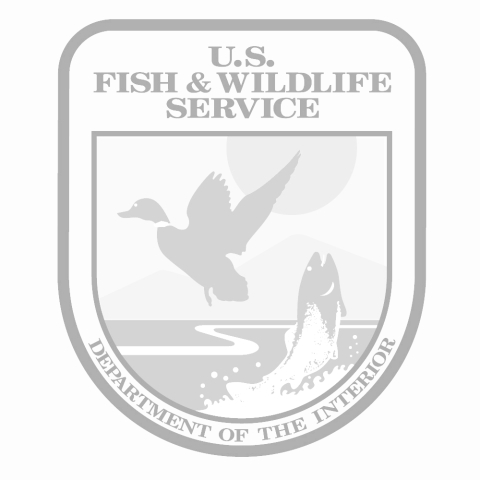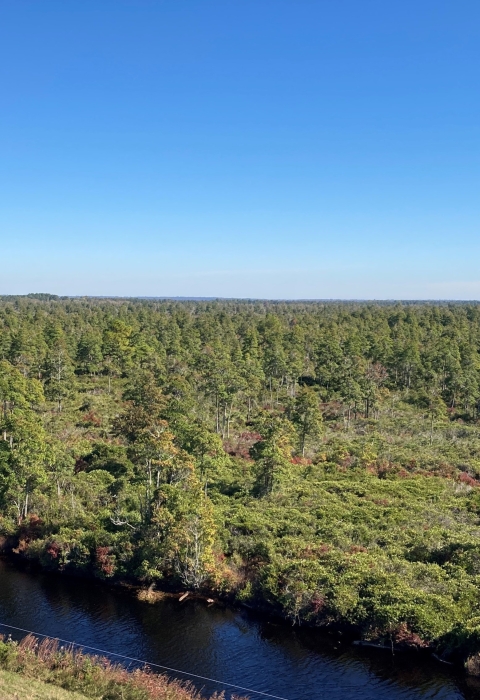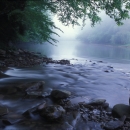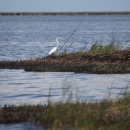Overview
Beginning in the 1940s, industrial facilities and wastewater treatment plants on the Saginaw River, Michigan, released PCBs (polychlorinated biphenyls) and related compounds into the Saginaw River. Because of on-site contamination, releases from the facilities continued after PCBs were banned in the 1970s. PCBs released into the Saginaw River ended up in sediments, fish, and wildlife in the Saginaw River and Saginaw Bay ecosystem.
Saginaw Bay, which drains into Lake Huron, is one of the prime walleye fishing and waterfowl hunting areas in the Great Lakes. Contamination has impacted fish and wildlife in the Saginaw River and Bay, resulting in advisories against human consumption of fish for all species of fish in the river and many species of fish in the bay. Wildlife that eat fish, including bald eagles, have had significantly lower reproductive success in these areas than has been found in less contaminated areas.
Trustees Take Action
A co-trustee group consisting of the U.S. Fish and Wildlife Service, the State of Michigan, and the Saginaw Chippewa Indian Tribe of Michigan (collectively known as the Natural Resource Trustees), pursued a process known as Natural Resource Damage Assessment and Restoration (NRDAR). The Natural Resource Trustees reached a negotiated settlement for natural resource damages with General Motors Corporation and the cities of Bay City and Saginaw in 1998. The settlement, estimated to cost General Motors over $28 million at the time, consisted of a combination of projects that General Motors and the cities would implement along with funding that they would provide to the Natural Resource Trustees for their past costs as well as for future restoration and monitoring. The settlement provided for substantial cleanup of river contamination and continues to provide for protection and restoration of fish and wildlife habitats in and around the Saginaw River and Bay.
Restoration
Restoration actions completed by 2005 as the result of the settlement include the following:
· Dredging of the lower Saginaw River to remove over 342,000 cubic yards of contaminated sediments estimated to contain 90% of the mass of PCBs in the lower river
· Acquisition, restoration, and protection of over 1,600 acres of land along the Saginaw River and Saginaw Bay, including restoration of coastal wetland habitats on land formerly drained for agricultural use. Much this land is now open for public recreational use as part of Bay City State Park and multiple State Game Areas around the bay in Arenac, Bay, Tuscola, and Huron counties
· Acquisition of land at the mouth of the Saganing River for the Saginaw Chippewa Indian Tribe of Michigan
· Improvement of fish habitat in Tobico Marsh by improving water flow through the marsh and between the marsh and Saginaw Bay
· Restoration of habitat of the Green Point Environmental Learning Center in Saginaw under the management of the U.S. Fish and Wildlife Service under a lease agreement with the City of Saginaw
· Two new boating access sites along the Saginaw River (Edward M. Golson Boat Launch & Nature Area, which includes nature trails and river overlooks on 43 acres in Bay City, and the Cass Avenue Boat Launch in Bay City) and one along Saginaw Bay (Jones Road Boat Launch)
· Monitoring of PCB concentrations in caged fish
In May of 2021, the Natural Resource Trustees for the Saginaw River and Bay finalized their Restoration Plan for the use of funds remaining from the 1998 Settlement. Approximately $5.0 M was designated for implementation of projects described in the Restoration Plan and $750,000 was reserved to fund future restoration project ideas identified by stakeholders in the Saginaw River and Bay area. The focus of the projects described in the 2021 Restoration Plan is enhancement of the restoration projects from the original settlement while also providing for their long-term stewardship.
Then in November of 2021, the Natural Resource Trustees for this case worked with the Trustees for the Tittabawassee River NRDAR case by combining the reserved $750,000 with $5,000,000 from the Tittabawassee River case to solicit restoration project proposals for the Saginaw Bay watershed from the public.
Based on the proposals received and project selection criteria for the NRDAR cases, the Trustees proposed a suite of projects to the public in February of 2023. After responding to public comments, the Trustees selected projects to implement in their Tittabawassee River – Saginaw River & Bay Natural Resource Trustee Councils Final Supplemental Restoration Plan and Environmental Assessment, published in July of 2023. These new projects are being implemented with partners and include the following:
· Habitat enhancement and management with the Saginaw Basin Land Conservancy
· Restoration and monitoring of lake sturgeon in Saginaw Bay with The Conservation Fund and others
· Invasive species management with the Saginaw Bay Cooperative Invasive Species Management Area, focused at Bay City State Park
· Additional land to be added to the Crow Island State Game Area
· Habitat restoration and accessible shoreline fishing access at the Saginaw River Headwaters Rec Area with Saginaw County Parks
· Habitat enhancement and riverbank stabilization feasibility study at Thomas Township Nature Preserve
· Tittabawassee River floodplain protection and restoration with Ducks Unlimited
· Riverfront restoration with the City of Midland
· Habitat management equipment for the Chippewa Nature Center
· Shoreline fishing access near Smith’s Crossing on the Tittabawassee River with The Conservation Fund and others, if found to be feasible at this location.
Contact Information



